Final Report for FNC13-907
Project Information
The purpose of this study was to measure the relative success of paper mulch in controlling pest population in vine crops that are more susceptible to cucumber beetles (Acalymma vittatum), squash vine borer (Melitta curcurbitae) and squash bug (Anasa tristis). The study design included multiple replications over a two year period with a control (no paper) and treatment (paper mulch). Weather conditions during the period of study required alterations in the method and scope of this project.
Weather conditions on the farm in 2013 forced modifications to the study for the duration of the first year. Longer season vine crops were eliminated from production and were not available for the study. We added short season vine crops (summer squash and zucchini) in an effort to move the study forward despite the weather. In 2014, melons were planted using the outlined study protocol with four replications of the treatment and control. Weather prevented timely planting of the winter squash.
Results for summer squash and zucchini showed no significant difference in production or pest presence during the trial. A limited trial on shorter season melons and winter squash in 2013 showed differences in young plant survival rates. A very limited trial on short season watermelon showed no differences.
Weather conditions the following year significantly altered the useful life of the paper mulch applied for the study. On the day of application and planting, strong wind and rain tore sections of the paper, killing a significant portion of the 750 transplanted melon seedlings. Continued rain led to premature degradation of the paper on the edges. This led to lifting of the mulch that destroyed additional plants. We were forced to add straw mulch to hold the paper down and prevent further damage. No useful results were collected in 2014 for the project.
Introduction:
Production of cucurbits becomes more challenging with the presence of various pest populations, such as cucumber beetles (Acalymma vittatum), squash vine borer (Melitta curcurbitae) and squash bug (Anasa tristis). Not only do these pests damage these crops by girdling seedlings (cucumber beetles), destroying the flow of nutrients through the stem (vine borers) or consuming leaves and flowers (cucumber beetles and squash bugs), but they may be vectors to diseases that will hinder or destroy the crop. Yellow Vine Decline is spread by squash bugs and cucumber beetles are known to be a persistent vector of bacterial wilt. Prior data from our farm indicates to us that a loss rate comprising 60% of most winter squash and melon vines was not uncommon for some heirloom/open pollinated varieties.
The most common technique for handling these pest populations is to maintain a consistent application of pesticides. However, this is an issue for growers who maintain organic certification or wish to reduce the application of chemicals. Further, continued application of these chemicals often reduces populations of beneficial insects desired by the grower. Many organic growers utilize row covers to exclude these pests. However, covers must be removed to allow for pollination. Further, row covers can present some management issues with respect to weed control and management in windy, unsheltered areas.
Good sanitation practices and selection of resistant varieties can also play a part in reducing losses to these pests. While both are accepted as good practices by professional growers, there is still a desire to grow vine crops that are more susceptible to these pests without the use of chemicals and with a reduction in crop management, all while using techniques that have a reduced negative impact on the environment.
An increasing number of horticulturalists are finding ways to use plastic mulch as an important component of their growing systems. However, many indicate that, while it appears to work in reducing weeds, it seems to be incongruous with a sustainable operation that hopes to minimize negative impacts on the environment. Paper mulch has been considered as an option on and off for some time with a study as early as 1996 comparing plastic and paper (Project Number: AS93-007). For example, a prior study in Vermont (Project Number: FNE05-562) illustrated complete failure of paper mulch due to splits in the paper at the point the mulch was laid. Another study in 1988 suggested that paper mulch may not be adequate for larger scale operations (Project Number: LS88-011). However, neither of these studies considers some newer developments in the product, nor do they illustrate the intention of the researchers to determine what needs to be done to make application of the product efficient and effective.
In addition to weed control, there have been anecdotal and research-based results that suggest synthetic mulches may aid in controlling pest populations. Of particular interest is a study mentioned in the prior section (SARE Project Number: LS01-127). The study shows a combination of coated mulch and companion plants to be significantly beneficial in the control of cucumber beetles. The University of Florida also performed a control vs 6 treatment study that included plastic mulch as a one of several controls for pests in that region with some success (ACCESSION NO: 0200846 SUBFILE: CRIS). Our own preliminary research indicates a reduced loss of cucurbit seedlings on paper mulch. However, we found no similar studies involving paper mulch. It was our opinion that the paper mulch option will not be considered by most growers until research is undertaken to illustrate benefits in addition to a reduction in disposal costs to the environment and the farmer.
The purpose of this study is to measure the relative success of paper mulch in controlling pest population in vine crops that are more susceptible to the previously named insects.
Dependent variables include pest presence, plant loss, yield and farm resource use.
Pest Presence:
We focused on the presence of the three pests listed in the introduction (cucumber beetles, squash bug and vine borers). Weekly observations were made on Mondays at three points during the day (morning, afternoon and evening), with an effort to make these observations at roughly the same time each day. It was hypothesized that there would be reduced presence of the pests identified on the paper mulch.
Plant Loss:
Plant loss were recorded by actual counts and by photo records. Plant loss rates were recorded only up to the point that plants begin to sprawl (vines over 2 feet long). Typical plant sprawl makes plant loss recording difficult and prior experience has indicated that the majority of loss occurs in the first two weeks after transplant. The focus of this study was on this period of plant development.
Yield:
Yield was measured at the point of harvest by maintaining records of fruit count and total fruit weight for each treatment/replication section.
Farm Resource Use:
Paper mulch has not gained much traction due to its higher cost per foot. An analysis of farm resource use for comparison between treatment and control was kept in order to determine if paper mulch resulted in a net gain or loss in farm resources during this project.
Cooperators
Research
Research Plan:
- Research Question: Will the application of paper mulch with cucurbits reduce pest pressure with an appropriate cost/benefit ratio for a sustainable operation?
- Scope: This study was implemented on cucurbits known to be more sensitive to the following pests: cucumber beetle, squash bug and vine borer. We selected open pollinated squash and melon varieties that have had a history of crop loss due to these pests.
- Control: Each replication included a bare soil planting of the selected cucurbit varieties. All plants will be transplanted. Only cultivation for weed control.
- Treatment: Plants were transplanted into heavy-weight paper mulch.
- Cultivation between rows (where mulch was not covering soil) was required to avoid any bias introduced by volunteer plant proximity. Irrigation drip tape was provided to all rows. Transplant spacing was the same for all rows.
- Variables: The independent variables was the inclusion of paper mulch. Dependent variables included pest presence, plant loss, yield and farm resource use.
- Controlling External Variables: Processes such as cultivation, mulch, irrigation, etc were undertaken on each treatment within each replication during the same time frame. All replications were completed in a time frame that was as close as possible given resource ability. Cultivar choices were consistent across treatments. Data collection was taken away from the edges of each treatment block.
- To avoid destruction of the paper mulch by deer, we placed a single strand fence around the plots used for the study to discourage their traffic.
- Replications each year: Year one replications were limited by weather. Two replications for summer squash/zucchini and one for melons were accomplished. In year two, four replications of melons were planted and set up for study.
- Randomization: Coin flips were used to determine location of the paper mulch treatment.
The melon varieties were modified to focus more on the shorter season varieties on our heirloom list. These included Minnesota Midget, Eden's Gem and Ha'Ogen. Some of the longer season varieties were planted with the knowledge that the time was too short for them to mature, this included Boule d'Or, Oka and Pride of Wisconsin. 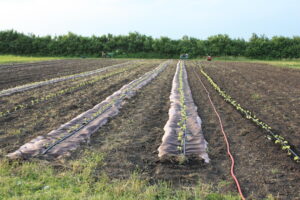
Two replications were completed using the paper mulch treatment versus the control (no paper mulch). Plant date was July 7, at least one full month after what we consider a normal 'safe planting date' on our farm for these crops. We were forced to destroy the first set of transplants as they were too old to produce. We did start a second set of transplants once it became obvious the first planting could not be put in soon enough. These were at peak transplant stage when we put them into the ground.
Results were as follows: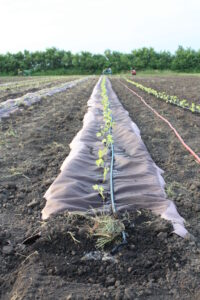
- Weed pressure was greater on the control rows.
- Plant loss on rows without the paper mulch within the first 10 days was twice as likely.
- Production numbers for all melons were very low.
- 80% of the production came from the treatment rows.
- Early loss could be traced to girdling by cucumber beetles.
Because of weather considerations, we do not place great significance on these results at this time. A warmer Fall with a late frost date is the only reason we saw any production from most of these plants. We would prefer to see a full growth season that fits into normal pest life cycles that would be experienced by these crops. We feel that we were on the tail end of the first generation of cucumber beetles at the time of planting.
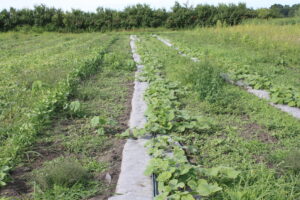
2013 Study Results Open Pollinated Watermelons
Watermelons were limited to a very short season variety (Sweet Siberian). No differences were determined between treatment and control.
2013 Study Results Open Pollinated Winter Squash
Winter Squash was limited to acorn and spaghetti squash. Some space was given to Burgess Buttercup, but these did not have the time to mature. Transplants, in this case, were older than desired at the point of planting. Soil was extremely rough due to our working the soil when it was still too wet. Despite the rough conditions, we had little trouble laying the paper with the mulch layer. Instead, we had difficulty planting into the rough soil.
Results were as follows:
- significant early plant loss occurred in the control rows due to root exposure in the rough soil
- 80% of the harvest, which was minimal, were in the treatment rows
The rough soil prevented good contact with the root balls. Also, plants were older than normally desired when they were transplanted, thus they would be subject to more transplant shock. The paper mulch worked as any mulch would, protecting the plants some from the winds that dried out the root balls on the unmulched plants. All plants were drip irrigated at transplant and as needed thereafter. However, very strong winds made it difficult for the control plants.
Yield from the acorn and spaghetti squash were at approximately 25% the normal harvest levels. Results should not be extrapolated from this season due to the extraordinary nature of the weather in 2013.
2013 Study Results Summer Squash and Zucchini
Summer squash and zucchini were not originally in the plan. However, since our season was compressed, we were able to add them to the study. In a typical season, we grow three to four successions of these crops, thus making it difficult t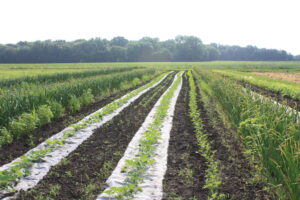 o come up with replications that had enough size to be worthwhile to include in the study with the two treatment variables. However, in 2013, our successions were compressed roughly into one, thus we were able to do reasonably sized replications.
o come up with replications that had enough size to be worthwhile to include in the study with the two treatment variables. However, in 2013, our successions were compressed roughly into one, thus we were able to do reasonably sized replications.
As with other vine crops, we were forced to compost most of our first transplant trays and had to use later transplants in the field. We were also forced to reconfigure fields to work around wet areas. Sections that were planted into areas that were obviously affected by the moisture were removed from the study replication areas.
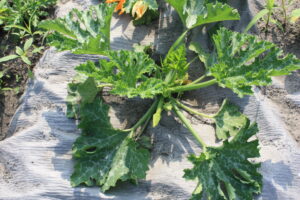 |
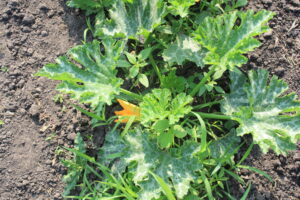 |
Results were as follows:
- no difference in plant loss was observed
- no significant difference in yield was observed for most varieties
- Golden Zucchini showed significant young plant loss in the control and minimal in the treatment areas
- weed control was better in the treatment rows early and worse late. However, the crops were ready for termination at that point.
- control plants showed faster early growth, but did not produce any earlier than treatment rows. The latter caught up in size at the point of first production.
2014 Study Results Open Pollinated Melons and Watermelons
A full 200 foot by 60 foot plot on our farm was dedicated to melon and watermelon production in 2014. The field was split into eight beds and were paired into treatment and control combinations using a coin flip. This effectively gave us four replications for the study for each cultivar. Open pollinated melon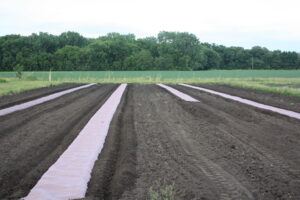 s in the trial included Eden's Gem, Ha'Ogen, Pride of Wisconsin, Oka and Boule d'Or. Watermelons included Sweet Siberian, Orangeglo and Mountain Yellow Sweet. Each replicated pair was separated by a planting of either zinnia or borage.
s in the trial included Eden's Gem, Ha'Ogen, Pride of Wisconsin, Oka and Boule d'Or. Watermelons included Sweet Siberian, Orangeglo and Mountain Yellow Sweet. Each replicated pair was separated by a planting of either zinnia or borage.
The field and beds were prepared on June 15. Paper was laid the next day and all transplants were put in the next day. Soon after completion of the planting, winds picked up and heavy rain fell. As a result, five sections of paper, from five to fifteen foot long, tore and flapped onto the transplants. In those sections, plants were a complete loss. Some pa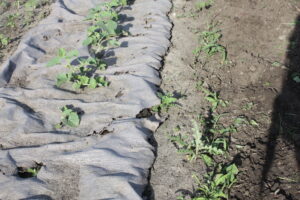 per actually extended into a control section and destroyed five plants in that area.
per actually extended into a control section and destroyed five plants in that area.
Significant rains after the transplant date prevented further field work, thus the winter squash trials were not completed. These rains and their timing accelerated the breakdown of the paper at the edges where the paper was anchored by the soil. As a result, paper began lifting off of the rows just as the plants were beginning to vine out, destroying more plants. In order to avoid further loss, we spread straw mulch over the paper mulch to keep it from lifting.
Results were as follows:
- Minimal seedling loss was noted due to pests in the treatment rows
- Significant seedling loss was noted due to paper mulch failure in the treatment rows
- Seedling loss for Eden's Gem due to pests was 25% in the control rows
- Seedling loss for Eden's Gem due to pests was 5% in treatment rows.
- Seedling loss for Oka was 18% in the control rows.
- Seedling loss for Oka due to pests was 5% in treatment rows.
- Seedling loss for Ha'Ogen due to pests was 40% in the control rows.
- Seedling loss for Ha'Ogen due to pests was 8% in the treatment rows.
- Seedling loss for Pride of Wisconsin due to pests was 5% in both control and treatment.
- Seedling loss for Boule d'Or was not observed due to heavy losses from paper mulch failure.
- All losses reported were adjusted to reflect remaining plants after paper mulch failure losses.
- Per plant production was statistically the same for all cultivars across treatment and control replications
- There were no differences observed between control and treatment for the watermelon varieties
Two Year Study Results - Resource Utilization
It was difficult to assess resource costs since the weather across both seasons was extraordinarily difficult for our production. As expected, weed control costs were lower wherever paper mulch was applied. This actually was true even during 2014 when sections of the mulch failed. On the other hand, planting took 20% more person hours into the paper (hand planting in both treatment and control). And, clearly, the cost of the paper is a major component of resource use with pricing per linear foot being significantly greater than alternatives such as plastic mulch.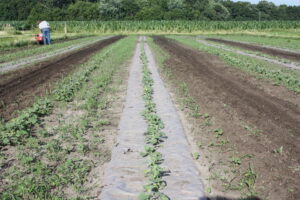
A summary of results were as follows:
- 48" wide paper mulch cost 28 cents per linear foot to purchase after discounts and shipping were applied
- weed control labor costs for the treatment were 37% of the cost for the control replications
- planting labor costs were nearly four times higher for the treatment
- additional labor costs were attributed to the paper mulch in 2014 due to mulch failure
- additional mulch costs were attributed to paper mulch failure in 2014
- other labor costs were equivalent between the two applications
- overall costs for treatment rows were 79 cents per foot versus 30 cents per foot in the control
Sample costs using paper mulch for 100 foot melon row in 2014:
- mulch: $28
- mulch laying labor using $10/hour rate: $7
- planting labor cost hand planting & dibble to create holes: $9
- labor cost due to mulch failure: $25
- weed control labor costs: $10
- total cost per 100 foot: $79
Sample costs for bare soil in a 100 foot melon row in 2014:
- planting labor cost (hand plant): $2.50
- weed control labor costs: $27
- total cost per 100 foot: $29.50
Crop Value Using Eden's Gem in 2014: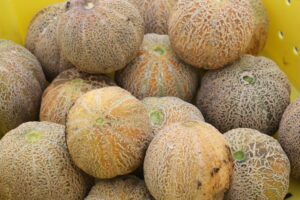
- 80 row foot of production for both control and treatment
- 25% loss of seedlings due to pests in control
- 5% loss of seedlings due to pests in treatment
- no losses observed due to paper mulch failure for this cultivar
- 65 melons harvested in the treatment rows
- 54 melons harvested in the control rows
- direct sale value of $4/ melon at market
- treatment value: $260 for 80 foot
- control value: $216 for 80 foot
Value Less Cost Analysis, Eden's Gem 2014:
- A better value for the treatment of 5.5 cents per row foot with Eden's Gem in 2014 without including equipment costs.
| Treatment | Control | Difference | |
| Crop Value per linear foot | $3.25 | $2.70 | +$0.55 |
| Cost per linear foot | $0.79 | $0.295 | +$0.495 |
| Return per linear foot | $2.46 | $2.405 | +$0.055 |
Summary of Value Analysis:
Only Eden's Gem survived without damage when the paper mulch failed in 2014. Other varieties clearly showed much better value in the control as compared to treatment due to losses attributable to this failure. We can only say that for some varieties, paper mulch could reduce early plant loss sufficiently to cover the additional cost of the paper mulch. But, since some varieties showed no difference in early loss, a simpler solution might be to grow those varieties rather than expend effort on the paper mulch.
The only question here is how much overhead cost could be attributed to laying paper mulch versus the control. We made some effort in determining these numbers and concluded that equipment costs were roughly equivalent since the tractor was used in both situations for similar times and the walk behind tractor balanced out the mulch layer for costs specific to treatment versus control.
Analysis Without Mulch Failure:
In the past, we have not seen paper mulch failure on the scale that we experienced it in 2014. If we accept that the weather conditions were exceptional and that paper mulch would not break down too quickly in most years, we could remove the additional cost incurred in 2014, which would give us the following breakdown:
| Treatment | Control | Difference | |
| Crop Value per linear foot | $3.25 | $2.70 | +$0.55 |
| Cost per linear foot | $0.54 | $0.295 | +$0.245 |
| Return per linear foot | $2.71 | $2.405 | +$0.305 |
Impact of Results/Outcomes
Weather conditions limited what we were able to accomplish during the grant period. However, we feel we have enough data to indicate that there may well be positive benefits to including paper mulch in an open pollinated melon growing system for certain cultivars. While we were unable to collect enough data to show any statistical significance, we think there is enough to encourage further research in this area for varieties such as Eden's Gem, Oka and Ha'Ogen.
The difference between the treatment (paper mulch) and control (bare soil) for the cultivars mentioned above was clearly in the reduction of seedling loss within the first two weeks of transplant. We attribute most of the loss to girdling by cucumber beetles, though some of the loss could be due to root exposure in rough soils that dried the plant out. Once plants had grown past the early stages, the paper mulch did not appear to do anything more than provide some weed control for any of the cultivars trialed.
As with any tool, there is certainly a learning curve that must be climbed with respect to the use of paper mulch. It is also clear that paper mulch will not be the best tool in all situations, though it likely will have its places. We found that we favored the heavier, creped paper that did not have prepunched holes. We also found that the whole process works best if the bed is pre-tilled prior to application to reduce any clumping that could increase irregularities in how the paper lies in the bed. We also believe that if we planted and irrigated immediately after putting the paper in, we had less troubles with paper lifting in a strong wind after that point. It is entirely possible that if we were to do this research again, the data would be worthy of statistical analysis simply because we now have more experience using the product.
Educational & Outreach Activities
Participation Summary:
In August of 2014, we hosted a Practical Farmers of Iowa field day at our farm. This event included a farm tour. Among the topics discussed was the paper mulch SARE project as well as a prior SARE project completed on our farm in 2011 and 2012. There was strong attendance and many insightful questions at this event.
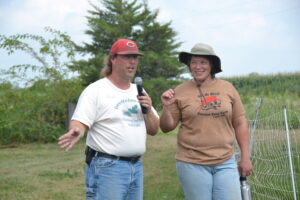
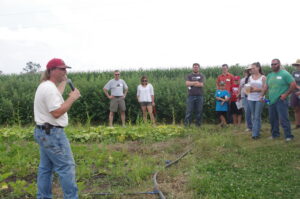

Project Outcomes
Potential Contributions
Given the results reported here, we see this research project as having the potential to encourage further research into non-chemical responses for controlling early loss in cucurbits to common pests. While the data collected was not in sufficient quantity within the study parameters, there does appear to be some evidence that paper mulch may help several open pollinated melons reach the vining stage.
Future Recommendations
We are of the opinion that paper mulch may, in fact, positively impact the production of some open pollinated melons, such as Oka, Ha'Ogen and Eden's Gem by preventing early plant loss to girdling by cucumber beetles. Further research would be required in order to acquire sufficient data to run statistical analysis. This research should be undertaken by producers who are already versed in the use of paper mulch rather than persons who are trying to learn how to optimally use the tool (as we did during this process). We continue to target the use of paper mulch for certain varieties on our farm and continue to see lower seedling loss numbers.
It is entirely possible that any kind of mulch that covers the ground will reduce loss of these melon seedlings. Our dedication to paper mulch is based on long term environmental ideals rather than fully economic necessity. While we did find that there could be some financial benefit to use the paper mulch (see Eden's Gem financial analysis), if the same benefits could be had with plastic mulch, the base economic numbers would be greater.
It is also possible that a mulch, such as straw could have similar benefits to paper, but there may be an increase in organic matter as that mulch breaks down versus the organic matter left by paper mulch. Clearly, plastic does not do anything to improve soil health by adding to organic matter, so this question only applies to mulches that are allowed to break down in the field. It would be interesting to determine if long-term soil health benefits might contribute to offset financial deficiencies that might be a part of using paper mulch in a growing system.
In conclusion, it is clear that paper mulch still has some disadvantages that put it out of favor for most commercial growers. However, it seems clear to us that, despite the failures experienced during the process of this study, paper mulch technology is improving. We believe that there should continue to be some emphasis put into this development in hopes that the proper niches for its use can be identified, technology to improve its resiliency can be developed and costs to the grower might be reduced.